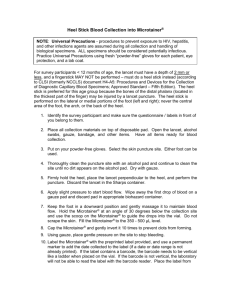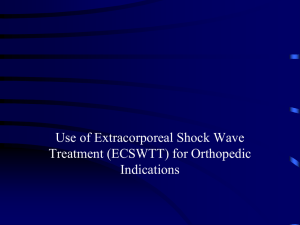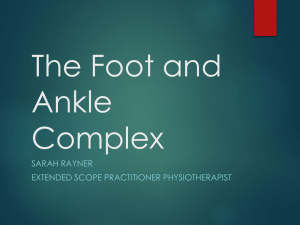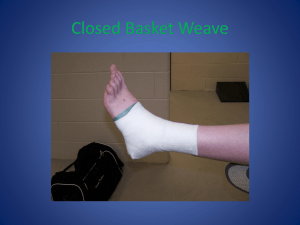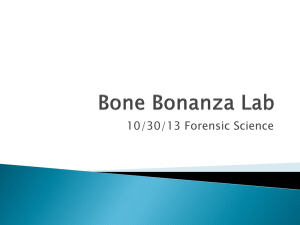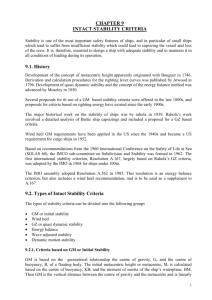Dermapad Customer Presentation
advertisement
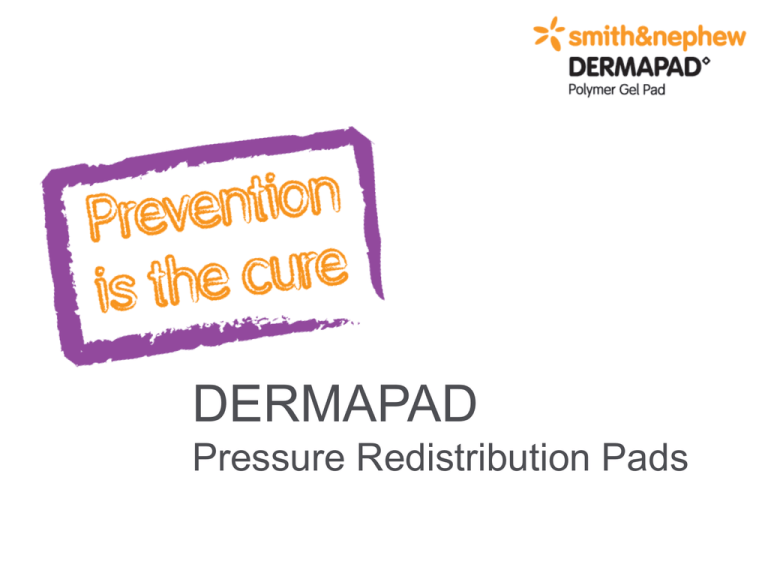
DERMAPAD Pressure Redistribution Pads Pressure Injury: a growing concern • Introduction of the National Safety and Quality Health Service Standard 8 (Preventing and Managing Pressure Injuries) into Public Health Services 1 • Publication of the Pan Pacific Clinical Guideline for the Prevention and Management of Pressure Injury 2 • Expansion of Pressure Injury prevention protocols in facilities including early risk assessment and elements such as : Adequate nutrition Regular repositioning Regular skin inspection Keeping the skin clean and dry Pressure injury outline of care Specialised devices (e.g. DERMAPAD™) DERMAPAD™ as part of a care plan DERMAPAD is a polymer gel pad that redistributes pressure to relieve critical areas3,4 Designed to help prevent pressure injuries3 Protects bony areas with less fatty tissue4 Redistributes pressure to avoid high pressure points3,4 Helps to reduce erythema and prevent progression of skin damage3 DERMAPAD™ as part of a care plan When to use DERMAPAD The pads are indicated for use on intact skin and can be used on: Areas at risk or areas already showing signs of developing skin damage5 Stage 1 pressure injuries to prevent deterioration and aid tissue recovery6 Recently healed pressure injuries to help prevent re-injury7 Under devices to prevent skin damage DERMAPAD™ as part of a care plan Where to use DERMAPAD DERMAPAD◊ can be used on bony areas that are subject to high pressure points, or under devices that cause pressure points DERMAPAD™ clinical Aged care facility Sylvie Hampton, Wound Healing Centre, Eastbourne UK An evaluation of DERMAPAD Heel Pad6 Methodology Results 28 residents in 3 aged care facilities All the treated heels improved showing less erythema Waterlow score >15 (high-risk) Ultrasound showed improvement below the skin Existing Grade 1 pressure damage Tissue returning to pre-injured state within 1 Visual & ultrasound inspection week after commencing treatment Treated with DERMAPAD for 2 months The heels without DERMAPAD did not improve Showing oedema Resembling uninjured skin within one week DERMAPAD™ clinical Hospital Sylvia Leonard, Luton & Dunstable Hospital UK An evaluation of shaped dermal pad in an acute care hospital5 Methodology Results 2 geriatric wards, 1 orthopaedics, 1 surgical 87% reduction in incidence of hospital acquired pressure injuries DERMAPAD used in conjunction with repositioning and regular skin inspections 75% decline in the overall number of pressure injuries Severity of pressure damage Number of pressure injuries Percentage Comparing incidence, severity and Pressure injury incidence number to 3 months prior 76% reduction in expenditure DERMAPAD™ product range Available in a wide range: 9 variants across 4 shapes Made from a unique polymer gel that acts like fatty tissue Highly conformable and flexible for use in all areas All variants can be cut with scissors for specific uses Can be held in place with a secondary fixation tape Can be washed and re-used by the same patient DERMAPAD™ Heel Heel • Standard • Large Long section across the foot for seated patients Long section across the heel for patients in bed Large variant for large feet or areas with swelling or fluid build-up Can also be used on elbows and knees Long section across the foot Long section across the heel DERMAPAD™ Heel fixation Heel Keep in place with a tubular bandage (e.g. TENSOGRIP®) Up to knee Up to knee Down to toes Put on the tubular bandage Down to toes Fold back the bandage and put DERMAPAD in place Stretch the bandage in an arch back over DERMAPAD Job done Note: the tubular bandage should be applied from the toes up to the knee to avoid swelling DERMAPAD™ Sacrum/Ankle Wrap Sacrum Ankle Wrap Sacral area Ankle wrap Around the shoulder or hip Around the back of the head DERMAPAD™ Sacrum/Ankle Wrap fixation Sacrum /Ankle Keep in place with body weight (do not use when mobile) Position DERMAPAD Sacrum on the mattress and rest the patient on top of it Use DERMAPAD Sacrum to protect the hip bone when repositioning Do not stretch or tug DERMAPAD Sacrum during repositioning Position between the patient’s lower back and the chair when seated (underwear can be used to keep in place) When used as ankle wrap, secure with TENSOGRIP® or HANDY ® CREPE bandage Can also be used to rest head or shoulders on DERMAPAD™ Sheet Sheet 10 x 10 x 0.3cm 20 x 20 x 0.3cm 10 x 10 x 1.2cm 20 x 20 x 1.2cm Under the foot or head whilst resting Between knees or between chin and chest Flat or folded for hand contractures (stroke rehabilitation) Large sheets around the foot or on the shoulder whilst lying down DERMAPAD™ Sheet fixation Keep in place with body weight Sheet Keep the sheet in place by lying on top of it (head; shoulders; babies) The 20x20cm sheets can be positioned on the bed to rest the heel or ankle Roll-up the 10x10cm sheets for hand contractures (no fixation needed) Place 10x10cm sheets between knees (no fixation needed) Keep the thin 10x10cm in place with OPSITE™ Flexifix Gentle if needed DERMAPAD™ Strip Strip 50 x 2.5 x 0.3cm 30 x 5 x 0.3cm Between fingers and toes Behind the ear Over the nose under face masks Wider strip is also commonly used down the spine DERMAPAD™ Strip fixation Strip Keep in place with OPSITE™ Flexifix Gentle silicone tape (or with whatever is causing the pressure) The strip is very versatile and can be cut to smaller pieces Keep in place between fingers or toes; or under oxygen masks Use wide strip along the spine (keep in place with OPSITE™ Flexifix Gentle ) Cut small pieces to use under tubing (keep in place with OPSITE™ Flexifix Gentle ) DERMAPAD™ instructions for use Indication: Protection against potential skin breakdown for patients at risk of pressure damage Directions 1. Select the appropriate size and shape from the range 2. Remove the product from the plastic container 3. Apply directly to the affected or at risk area (either side of the pad) 4. If necessary the pad may be secured with a suitable fixation device (e.g. OPSITE™ Flexifix Gentle, and TENSOGRIP® or HANDY ® CREPE bandage) 5. The skin under the pad should be inspected regularly in line with local clinical protocols 6. The pad can be washed in soap and water for re-use with the same patient. The pad must be dry before reapplication. Contraindications • Do not use on broken skin • Do not obstruct nose or mouth airways • If a skin reaction occurs discontinue use DERMAPAD™ skin inspection routine 1. Remove the DERMAPAD pad and inspect the skin 2. Cleanse the skin using a soap-free, pH balanced product such as SECURA™ Cleanser 3. Wash the DERMAPAD pad with soap and warm water, rinsing well 4. Dry the DERMAPAD pad and reapply, ensuring skin is also dry Add DERMAPAD to your patient checklist: Check if DERMAPAD is in place on at-risk areas Note: DERMAPAD can be marked with permanent marker with the patient’s initials or the site for application (e.g. “L heel”) DERMAPAD™ other benefits Reduces the Human cost of Pressure Injuries Contributes to a reduction of the impact of PI on patients’ quality of life4 Contributes to a reduction in morbidity4 Reduces the Economic cost of Pressure Injuries Can be washed and reapplied on the same patient3,4 Contributes to a significant decrease of the treatment costs associated with PI4 The introduction of Dermapad in a UK hospital generated a cost saving of 70% over 3 months • Fewer PI occurrences • Reduction in the severity of PI • Dermapad costs represented less than 2% of savings Can be easily incorporated into existing PI prevention protocols4 Requires minimal training3,4 Simple and intuitive to use3,4 3 years shelf life DERMAPAD™ summary DERMAPAD is a polymer gel pad that redistributes pressure to relieve critical areas3,4 9 variants across 4 shapes to fit all body parts Washable and re-usable on the same patient Can be cut to size with scissors Should be used as part of a wider care plan that includes repositioning and specialised equipment DERMAPAD™ ordering information S&N code DERMAPAD Qty/Carto n Cartons per case 66801315 Sheet 10 x 10 x 0.3cm 5 12 66801316 Sheet 10 x 10 x 1.2cm 5 12 66801317 Sheet 20 x 20 x 0.3cm 2 10 66801318 Sheet 20 x 20 x 1.2cm 2 6 66801319 Heel Standard 2 12 66801320 Heel Large 2 12 66801321 Heel Standard Bulk N/A 30 66801322 Sacrum / Ankle wrap 1 10 66801323 Strip 50 x 2.5 x 0.3cm 5 12 66801324 Strip 30 x 5 x 0.3cm 5 12 References 1. Australian Commission on Safety and Quality in Healthcare. National Safety and Quality Health Service Standards, September 2012. http://www.safetyandquality.gov.au/ourwork/accreditation/nsqhss/ Accessed 6 December 2012. 2. Australian Wound Management Association. Pan Pacific Clinical Practice Guideline for the Prevention and Management of Pressure Injury, 2012. http://www.awma.com.au/publications/publications.php#pipm Accessed 6 September 2012. 3. Hampton S, et al. Aderma heel pads in the prevention of pressure ulcers in nursing homes. Wounds UK 2012;8: 125-129. 4. Woods S, Aderma dermal pads in the prevention of pressure ulcers, Wounds UK 2012;8: 152-155. 5. Leonard S, Ormond K. An evaluation of a shaped dermal pad and their influences on pressure ulcers in an acute foundation trust. Poster presented at Wounds UK Conference, Harrogate; 2008. 6. Hampton S, et al. An evaluation of Aderma Heel Pad. Data on file; 2011. 7. Finn M. Patient Testimonial form; 2010. Trademark of Smith & Nephew © Smith & Nephew September 2012 ◊ Smith & Nephew Pty Ltd Healthcare Division New Zealand Australia 621 Rosebank Road, 315 Ferntree Gully Road (PO Box 242) Avondale Mount Waverley 3149 PO Box 442 Victoria Australia Auckland 1140 New Zealand T 61 3 8540 6777 T 64 9 828 4059 F 61 3 9544 5086 F 64 9 820 2867 www.smith-nephew.com.au/healthcare
